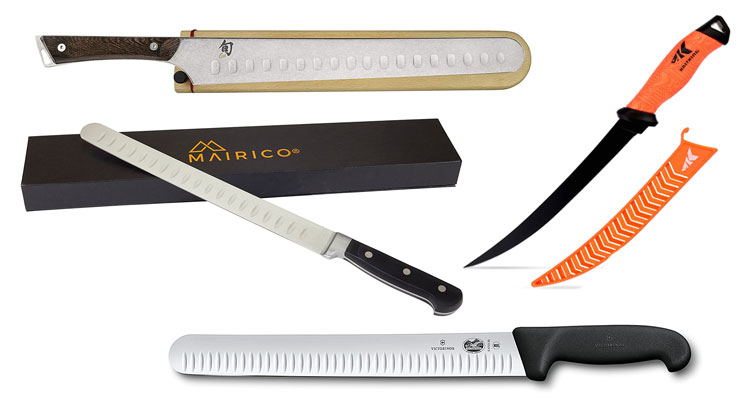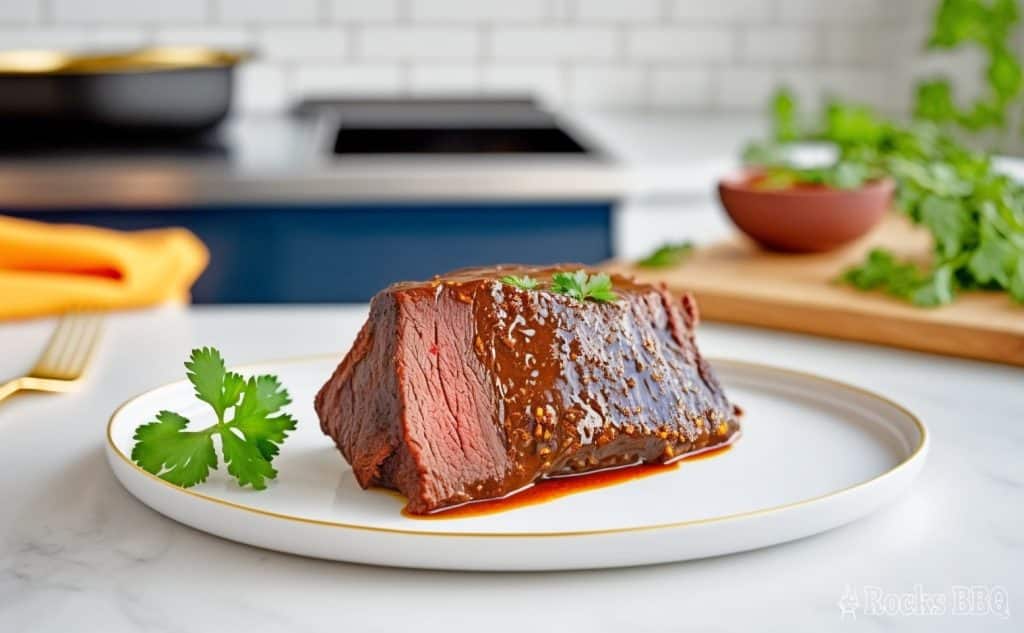
When it comes to cooking brisket, one of the most critical steps is often overlooked: resting. This process allows the meat to relax, reabsorb its juices, and become incredibly tender and flavorful.
In this guide, we’ll explore the science behind resting brisket, discuss the ideal resting conditions, and share professional tips to help you achieve perfectly juicy, tender, and delicious brisket every time.
Table of Contents
The Science Behind Resting Brisket
Why does brisket need to rest?
Resting is essential for all cooked meats, but it’s particularly crucial for beef brisket. As a cut that comes from a heavily exercised part of the cow, brisket contains a lot of connective tissue and collagen. During cooking, the collagen breaks down into gelatin, which contributes to the meat’s tenderness and juiciness. However, if you cut into the meat immediately after cooking, the juices would spill out, resulting in a dry and less flavorful brisket.
By resting the brisket, you allow the meat fibers to relax and reabsorb the juices, leading to a more tender and flavorful result. The resting period also lets the meat’s temperature stabilize, ensuring that the brisket is cooked evenly throughout.
How resting affects tenderness and juiciness
Resting brisket has a significant impact on its tenderness and juiciness. As the meat rests, the redistributed juices are reabsorbed by the muscle fibers, which helps to keep the brisket moist. Additionally, the proteins in the meat continue to break down during the resting period, contributing to a more tender texture. By giving your beef brisket adequate time to rest, you can achieve a melt-in-your-mouth, juicy, and tender final product that will have your guests asking for seconds.
Ideal Resting Conditions for Brisket
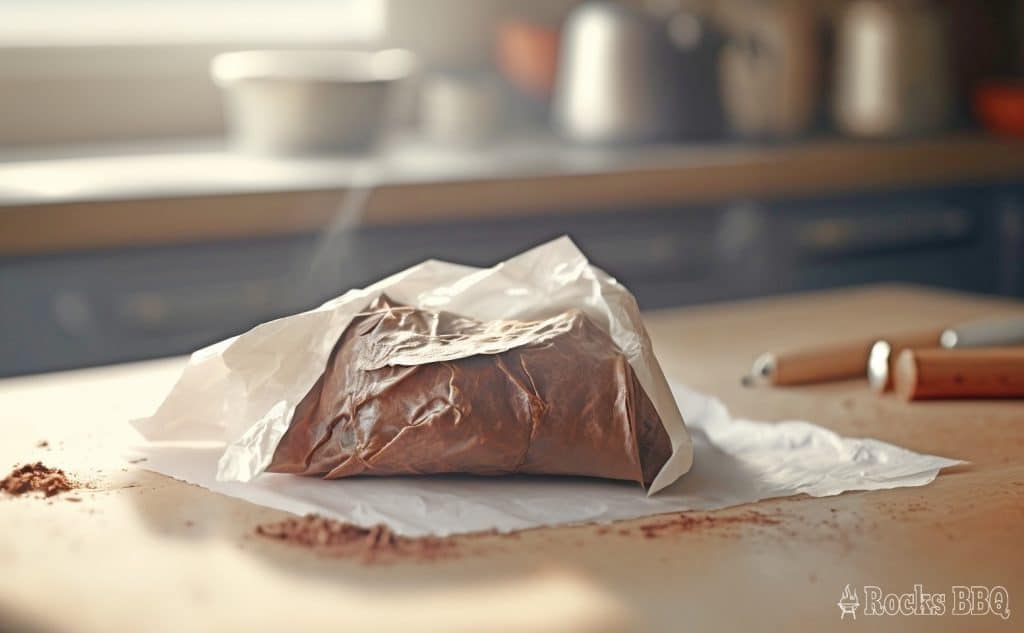
Wrapped vs. unwrapped brisket
The decision to rest your brisket wrapped or unwrapped depends on your desired outcome. Wrapping the brisket in aluminum foil or butcher paper can help retain moisture, making the meat juicier. It can also speed up the cooking process by trapping heat, which is particularly helpful when using the “Texas Crutch” method during smoking.
On the other hand, resting brisket unwrapped can result in a better bark, the crispy outer crust that many barbecue enthusiasts crave. If you choose to rest your brisket unwrapped, be sure to place it on a wire rack over a sheet pan to catch any drippings and prevent the meat from sitting in its juices, which could make the bark soggy.
Dry heat vs. moist heat
Brisket can be cooked using either dry heat or moist heat, but it’s important to consider which method is best for your desired outcome. Dry heat, such as smoking or grilling, creates a smoky flavor and a crispy bark. In contrast, moist heat, like braising or slow cooking in a liquid, can result in a more tender and juicy brisket, albeit without the crispy exterior.
When it comes to resting, both dry and moist heat methods benefit from allowing the brisket to rest to redistribute juices and relax the muscle fibers. However, moist heat methods may require a shorter resting time, as the meat is already more tender due to the cooking process.
Resting on the counter vs. using a cooler
Resting brisket on the counter is a straightforward method, as you simply need to place the meat on a cutting board or wire rack and tent it with foil to retain heat. However, this method may result in a faster drop in temperature, which can affect the final texture and tenderness.
Using a cooler to rest your brisket helps maintain the meat’s temperature for a more extended period, allowing for a more even and thorough resting process. To do this, wrap the brisket in foil or butcher paper and place it in a pre-warmed cooler with towels or a heat-retaining material, such as an insulated blanket.
Best cooler for resting meat
When selecting a cooler for resting meat, opt for an insulated, high-quality cooler with a tight-fitting lid. Brands like Yeti, Coleman, and RTIC make durable and well-insulated coolers that can maintain temperature for several hours, ensuring your brisket stays warm and continues to rest evenly.
How to Rest Brisket After Cooking: Step-by-Step Guide
Resting brisket after smoking
- Once the brisket reaches an internal temperature of around 195°F to 205°F, remove it from the smoker.
- Wrap the brisket in aluminum foil or butcher paper to retain moisture and heat.
- Place the wrapped brisket on a wire rack over a sheet pan or in a cooler (see below for cooler method).
- Allow the brisket to rest for at least 1 hour or until the internal temperature drops to around 145°F to 150°F.
Resting brisket without a cooler
- After cooking, remove the brisket from the heat source and place it on a cutting board or wire rack.
- If desired, wrap the brisket in aluminum foil or butcher paper to help retain moisture.
- Tent the brisket loosely with foil to hold in some heat while still allowing steam to escape, preventing the bark from becoming soggy.
- Allow the brisket to rest for at least 30 minutes to 1 hour, depending on the size of the brisket and your desired level of tenderness.
How to rest brisket in a cooler
- Preheat the cooler by filling it with hot water and letting it sit for a few minutes. Then, empty the water and dry the cooler.
- Once the brisket is done cooking, wrap it tightly in aluminum foil or butcher paper.
- Place a folded towel or insulated blanket at the bottom of the cooler.
- Put the wrapped brisket on top of the towel or blanket and cover it with another towel or insulated material.
- Close the cooler lid tightly to retain heat.
- Allow the brisket to rest in the cooler for 1 to 4 hours, depending on your desired level of tenderness.
How long to let brisket rest in a cooler and how long can brisket rest in a cooler
Ideally, brisket should rest in a cooler for at least 1 hour, but it can be held in a cooler for up to 4 hours without compromising its quality. The specific resting time will depend on the size of the brisket and your desired tenderness.
What temp to pull brisket and put in cooler
Pull the brisket from the heat source when its internal temperature reaches 195°F to 205°F. This temperature range ensures that the collagen has broken down sufficiently, resulting in tender and juicy meat.
Keeping brisket moist and warm during resting
To keep brisket moist while resting, wrap it in aluminum foil or butcher paper, which helps retain the meat’s natural juices. To keep the brisket warm, tent it with foil if resting on the counter or use the cooler method to maintain temperature for an extended period. By following these steps, you can rest your brisket to achieve optimal tenderness, juiciness, and flavor, ensuring a delicious and satisfying meal.
Troubleshooting Common Brisket Issues
Why is my brisket juicy but tough/chewy?
If your brisket is juicy but tough or chewy, it’s likely that the collagen hasn’t broken down sufficiently during cooking. To resolve this issue, try cooking the brisket at a lower temperature for a longer period, allowing the collagen to break down more effectively. Alternatively, you can wrap the brisket in aluminum foil or butcher paper during the cooking process to help retain moisture and speed up the breakdown of collagen.
What dries out brisket?
Several factors can cause brisket to dry out:
- Cooking at too high of a temperature: High heat can cause the meat’s moisture to evaporate quickly, resulting in a dry brisket. Cook your brisket at a lower temperature for a longer time to ensure tenderness and moisture retention.
- Not enough fat or marbling: Brisket cuts with more fat and marbling tend to be juicier and more tender. Be sure to select a well-marbled brisket to maximize juiciness.
- Overcooking: Cooking brisket past its ideal internal temperature (195°F to 205°F) can cause the meat to become dry and tough. Use a meat thermometer to monitor the brisket’s internal temperature to avoid overcooking.
- Insufficient resting time: Resting brisket is crucial for retaining moisture and tenderness. Be sure to let your brisket rest for at least 30 minutes to 1 hour after cooking, or even longer if using a cooler.
Is brisket overcooked if tough?
A tough brisket can be a sign of overcooking or undercooking. Overcooked brisket becomes dry and stringy, while undercooked brisket will be tough and chewy due to insufficient collagen breakdown. To determine if your brisket is overcooked or undercooked, check the internal temperature with a meat thermometer. If it’s within the ideal range of 195°F to 205°F, the brisket may be undercooked and could benefit from additional cooking time. If the temperature is above this range, the brisket may be overcooked.
How often should I wet my brisket?
To keep your brisket moist during cooking, you can “wet” or mop it with a liquid, such as a mixture of apple cider vinegar, water, and your choice of spices. This process can help maintain moisture on the surface of the meat and add flavor. Mop the brisket every hour during the cooking process, being careful not to remove too much of the bark or seasoning. However, keep in mind that opening the smoker or oven door frequently can result in heat loss, which may extend the overall cooking time of your smoked brisket.
Professional Tips: How Do Restaurants Rest Brisket?
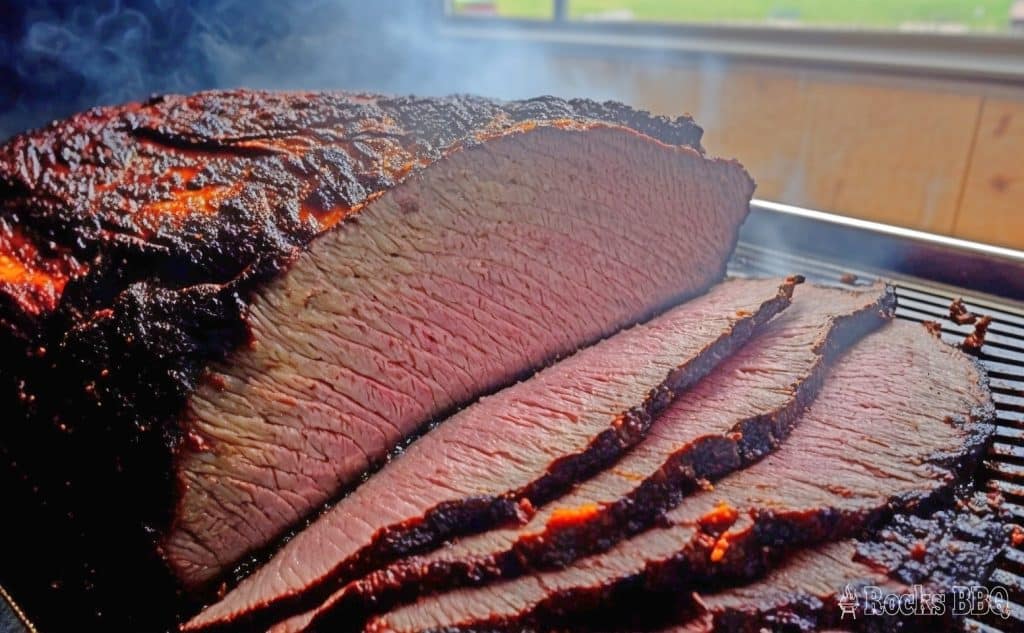
Restaurants and barbecue joints that specialize in brisket often have unique techniques for resting brisket to achieve the perfect balance of tenderness, juiciness, and flavor. Here are some common practices used by professionals:
- Wrapping in butcher paper or aluminum foil: Many restaurants wrap their briskets in butcher paper or aluminum foil during the resting process to retain moisture and heat, ensuring a juicy and tender final product.
- Using a holding cabinet: Some establishments use commercial holding cabinets to maintain the brisket’s temperature during the resting process. These cabinets provide a controlled environment, allowing the meat to rest at an optimal temperature for an extended period without drying out.
- Resting for an extended period: Professionals often rest their briskets for 2 to 4 hours, allowing the meat to reabsorb juices and achieve optimal tenderness. Longer resting times in a temperature-controlled environment can help improve the overall texture and flavor of the brisket.
By adopting these restaurant techniques, you can elevate your cooked brisket game and impress your guests with a delicious, tender, and juicy meal.
The Secret to Tender Brisket: Tips and Tricks
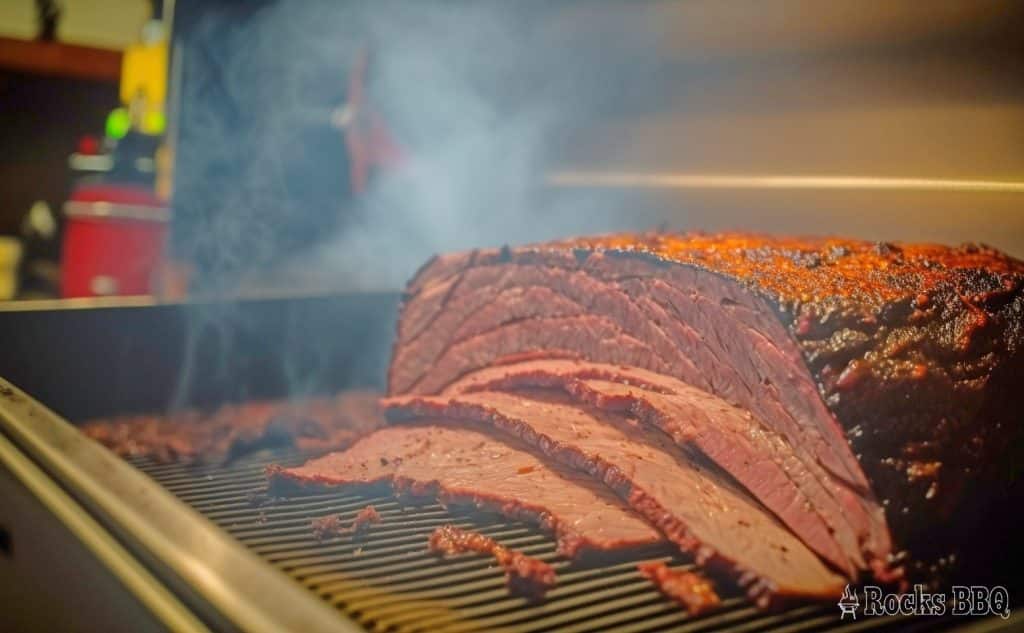
Proper cooking methods
Selecting the right cooking method is crucial for achieving tender brisket. Low and slow cooking methods, such as smoking or braising, allow the collagen in the meat to break down gradually, resulting in tender and juicy meat.
Choosing the right cut
When choosing a brisket, look for a full-packer cut, which includes both the point and the flat. This cut provides a balance of lean and fatty meat, ensuring a tender and flavorful result.
Importance of marbling
Marbling refers to the streaks of fat running throughout the meat. A well-marbled brisket will have a more even distribution of fat, which will render down during cooking and contribute to a tender and juicy final product. Look for a brisket with good marbling when selecting your cut.
Seasoning and marinating tips
Season your brisket with a dry rub of your choice, which can include salt, pepper, and other spices. Applying the rub at least a few hours before cooking, or even overnight, allows the flavors to penetrate the meat. Some cooks also opt to marinate the brisket in a liquid mixture to help tenderize the meat and add additional flavor.
Importance of cooking temperature and time
Cooking brisket at a low temperature (225°F to 250°F) for an extended period (usually 1 to 1.5 hours per pound) is key to achieving a tender result. The low and slow-approach allows the collagen to break down without drying out the meat. Monitor the internal temperature of the brisket during cooking, aiming for a target temperature of 195°F to 205°F. By following these tips and tricks, you can unlock the secret to a tender and flavorful brisket that will delight your family and friends.
FAQs: Addressing Common Brisket Resting Questions
Ideally, brisket should rest for at least 30 minutes to 1 hour after cooking to allow the juices to redistribute and the fibers to relax, resulting in more tender and flavorful meat. If using a cooler, the resting time can be extended to 1 to 4 hours for optimal tenderness.
You should let the brisket sit for at least 30 minutes to 1 hour before cutting it. This resting period allows the meat fibers to relax and reabsorb the juices, ensuring a tender and juicy final product. Cutting into the brisket too soon can cause the juices to run out, resulting in drier meat.
Yes, brisket will become more tender as it rests. The resting process allows the meat fibers to relax, which helps to improve tenderness. Additionally, the redistribution of juices within the meat during the resting period contributes to a more succulent and flavorful brisket.
Brisket needs to reach an internal temperature of around 195°F to 205°F for optimal tenderness. At this temperature range, the collagen within the meat breaks down into gelatin, which contributes to the meat’s tender, moist texture. Cooking the brisket to a lower temperature may result in a tougher, chewier texture, while overcooking it can cause the meat to become dry and stringy.
You can hold a brisket in a cooler for up to 4 hours without compromising its quality. The cooler helps to maintain the brisket’s temperature and moisture, allowing it to continue tenderizing while resting. However, it’s important to monitor the internal temperature of the meat to ensure it stays within a safe range (above 140°F) during the entire holding period.
The ideal resting time for a brisket in a cooler is at least 1 hour, but it can be extended to up to 4 hours for optimal tenderness. The specific resting time will depend on the size of the brisket and your desired level of tenderness.
In general, the recommended brisket rest time is at least 30 minutes to 1 hour if resting on a counter or wire rack, and 1 to 4 hours if resting in a cooler. The longer the brisket rests, the more tender and flavorful it will become, as the meat fibers relax and the juices redistribute throughout the meat.
Conclusion
Properly resting brisket is a crucial step in achieving tender, juicy, and flavorful meat. By understanding the science behind resting, following a step-by-step guide, and addressing common brisket issues, you can master the art of resting cooked brisket for an unforgettable dining experience. Implementing professional tips and learning the secret to tender brisket will further enhance your skills, ensuring you serve up a mouthwatering meal every time.
Resources for Further Reading
To master brisket cooking and resting techniques, explore resources such as:
- “Franklin Barbecue: A Meat-Smoking Manifesto” by Aaron Franklin and Jordan Mackay
- “Smoke & Spice” by Cheryl and Bill Jamison
- AmazingRibs.com – Comprehensive BBQ and grilling information
- BBQ Pit Boys YouTube Channel – Videos on various BBQ recipes and techniques


